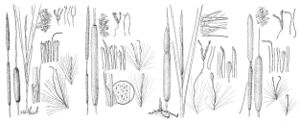Typhaceae
Herbs, perennial, of fresh to slightly brackish wetlands, often emergent, rhizomatous, caulescent in flower, smooth, glabrous. Leaves basal and cauline, 2-ranked, mostly ascending; sheaths open, margins overlapping, clear, summit tapered into blade or auriculate; blades twisted into loose helix, narrowly linear-attenuate, apex acute, aerenchyma prominent. Inflorescences 1, terminal, erect, equaled or exceeded by cauline leaves, cylindric, spikelike (hereafter "spikes"); staminate spike flowers deciduous but axis generally persistent; staminate spike distal to pistillate spike; young spikes subtended by early-deciduous bracts resembling reduced foliage leaves, 1 bract subtending pistillate spike, 1 bract subtending and several within staminate spike; ,staminate spike flowers deciduous but axis generally persistent; staminate axis with numerous simple or branched scales arising among flowers; pistillate axis with numerous projections ("compound pedicels"), evident on denuded fruiting spike, each bearing several flowers; in some species flowers subtended by slender bracteoles. Flowers unisexual, staminate and pistillate on same plants, numerous, densely packed in unisexual spikes, minute, wind-pollinated (stigmas receptive several days before pollen is shed); perianth probably represented by staminate scales and by hairs on stipes of pistillate flowers. Staminate flowers stipitate; stamens 1–several, filaments connate; anthers basifixed, connective distally extended. Pistillate flowers hypogynous, stipitate (stipe bearing numerous straight hairs, developing after flowering, acting in wind dispersal of fruits); pistils 1, 1-carpellate; ovariesy 1-locular; placentation apical; ovules 1; styles 1, unbranched; stigmas 1, whitish or green, drying brown, 1-sided, smooth; agamous flowers numerous (ovaries modified after flowering as carpodia). Fruits follicles, fusiform; pericarp clear, hyalinetransparent, splitting longitudinally in water to release seed. Seeds: endosperm starchy, oily; embryo cylindric.
Distribution
Boreal to tropical regions worldwide.
Discussion
The extensive literature on morphology and taxonomy of Typhaceae has been recently reviewed by (U. Müller-Doblies and D. Müller-Doblies (1977); R. M. T. Dahlgren and H. T. Clifford (1982); R. M. T. Dahlgren et al. (19853); and J. W. Thieret and J. O. Luken (1996). The inflorescence is probably reduced from a compound structure.
Sparganium and Typha are very similar and perhaps should be placed in one family, as summarized by J. W. Thieret and J. O. Luken (1996): T (J. W. Thieret and J. O. Luken 1996). Other authors (e.g., D. Müller-Doblies 1970; U. Müller-Doblies and D. Müller-Doblies 1977; W. Schultze-Motel 1980) placed Sparganium in the Typhaceae.
Pre-Englerian [authors] ... placed Typha and Sparganium together in a single family, the Typhaceae. [H. G. A.] Engler (1886) put these genera in separate families, thus starting a tradition that has been followed by almost all subsequent authors until recently, when [D.] Müller-Doblies (1970) re-examined the relationships of the genera and concluded that "the five different characters by which Engler justified the family Sparganiaceae are wrong or, in two cases, without any significance... The few remaining but very obvious differences may be explained to a large extend [sic] by an adaptation of Typha to anemochory [wind-dispersal of propagules]...."
The phylogenetic relationships of the Typhales with other families remain controversial, and it seems best to treat the taxon as an isolated order of uncertain relationships pending further research. Various authors have placed the Typhales close to or within the Pandanales, Arales, Poales, Liliales, Pontederiales, or Philydrales or in the Commeliniflorae generally close to the Cyperales and Juncales (J. W. Thieret and J. O. Luken 1996).
Genus Genera 1, species ca. 8–13 (3 in the flora).
